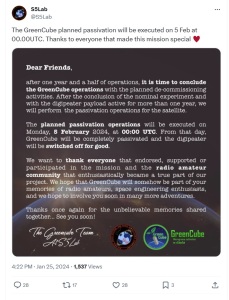At 1622 GMT on Thursday, January 25, 2024 @S5Lab posted on X that the GreenCube IO-117 Digipeater would be permanently deactivated on February 5.
Designed and developed by students of Sapienza University of Rome, GreenCube IO-117 was the first satellite to carry an amateur radio payload into Medium Earth Orbit (MEO) – 6,000 km.
IARU satellite frequency coordination information https://iaru.amsat-uk.org/finished_detail.php?serialnum=784
AMSAT Responds to Planned Decommissioning of IO-117 (GreenCube)
https://www.amsat.org/amsat-responds-planned-decommissioning-io-117-greencube/
The S5Lab post on X said:
Dear Friends,
After one year and a half of operations, it is time to conclude the GreenCube operations with the planned de-commissioning activities. After the conclusion of the nominal experiment and with the digipeater payload active for more than one year, we will pergorm the passivation operations for the satellite.
The planned passivation operations will be executed on Monday, 5 February 2024, at 00:00 UTC. From that day, GreenCube will be completely passivated and the digipeater will be switched off for good.
We want to thank everyone that endorsed, supported or participated in the mission and the radio amateur community that enthusiastically became a true part of our project. We hope that GreenCube will somehow be part of your memories of radio amateurs, space engineering enthusiasts, and we hope to involve you soon in many more adventures.
Thanks once again for the unbelievable memories shared together… See you soon!
The GreenCube Team at S5Lab










You must be logged in to post a comment.